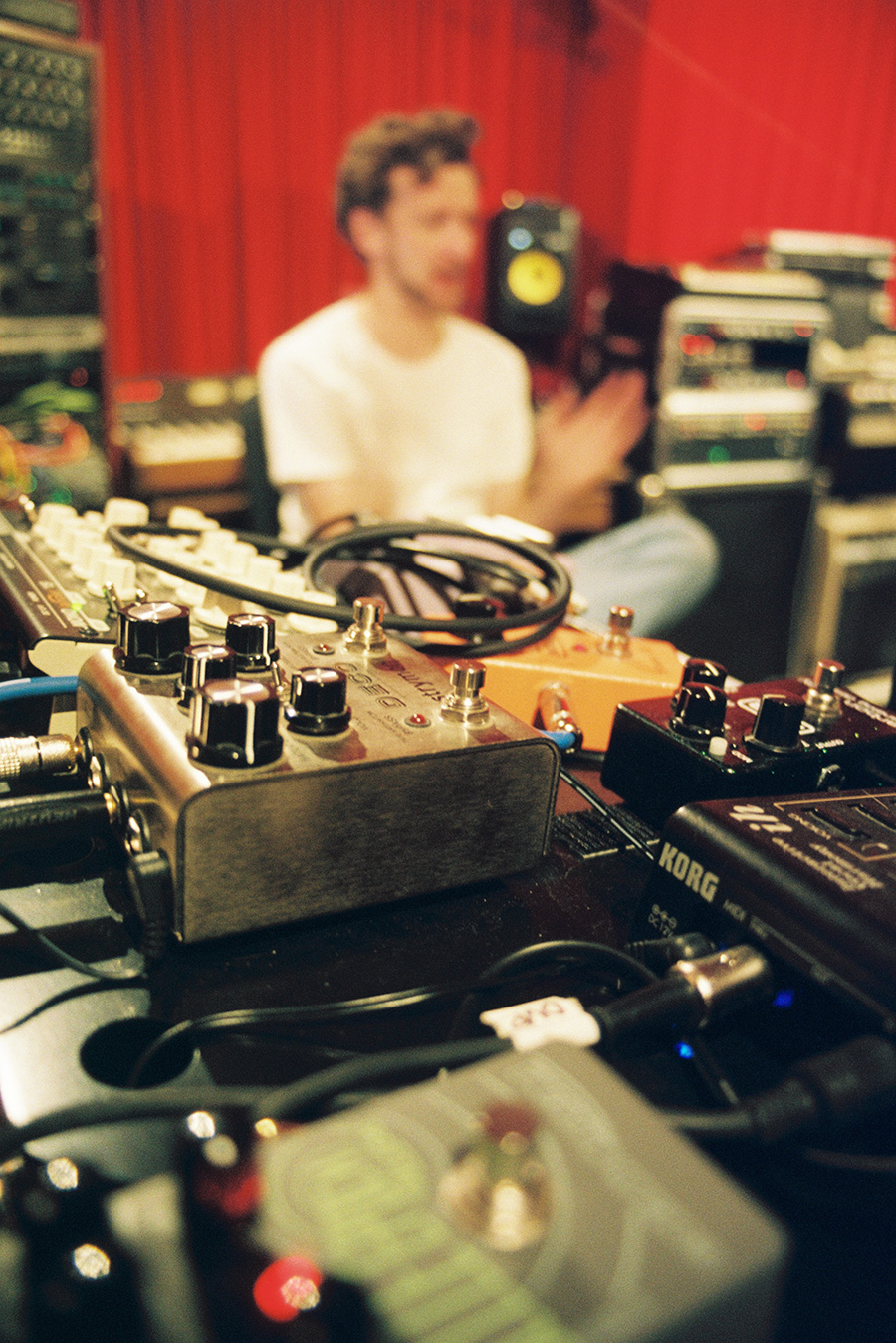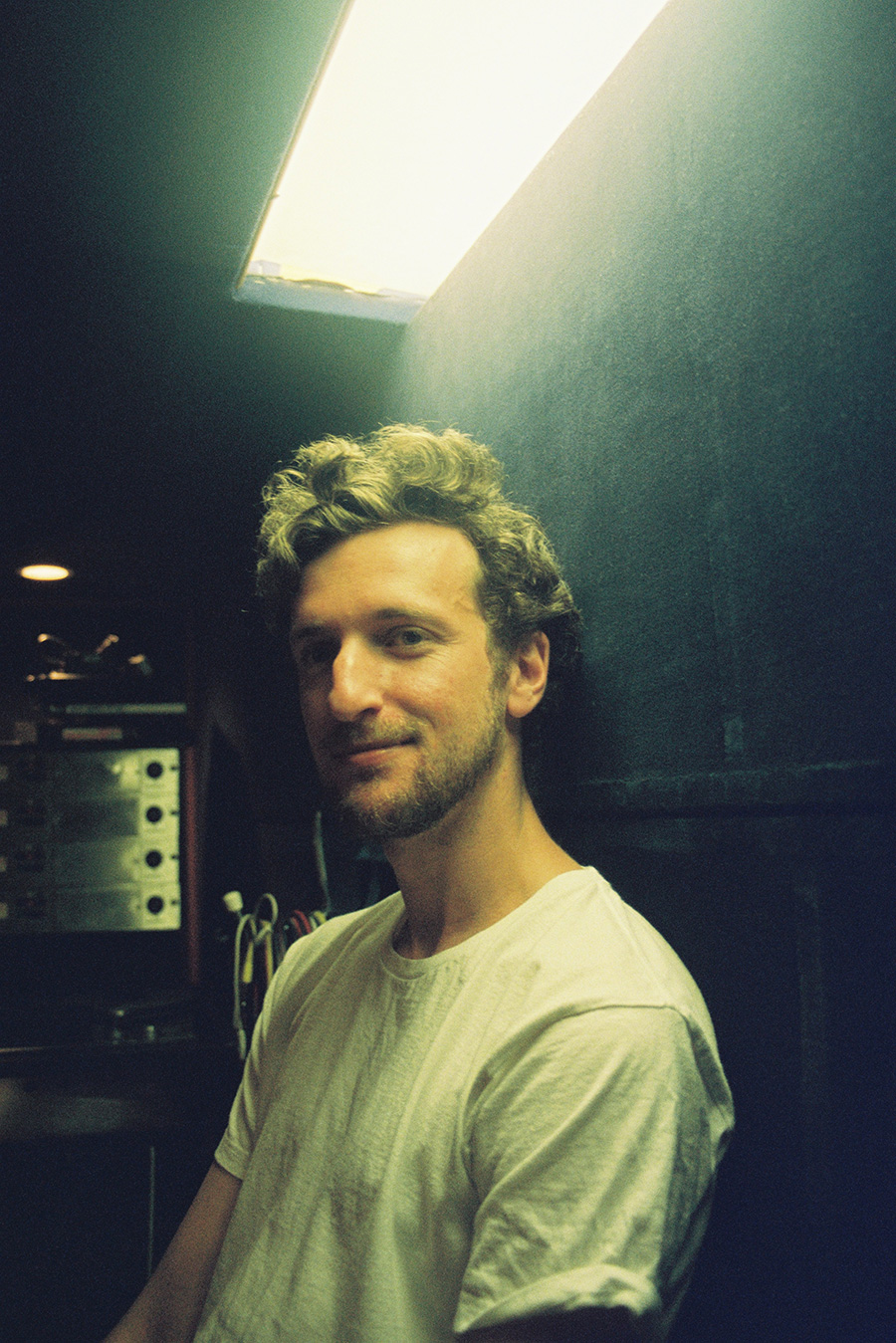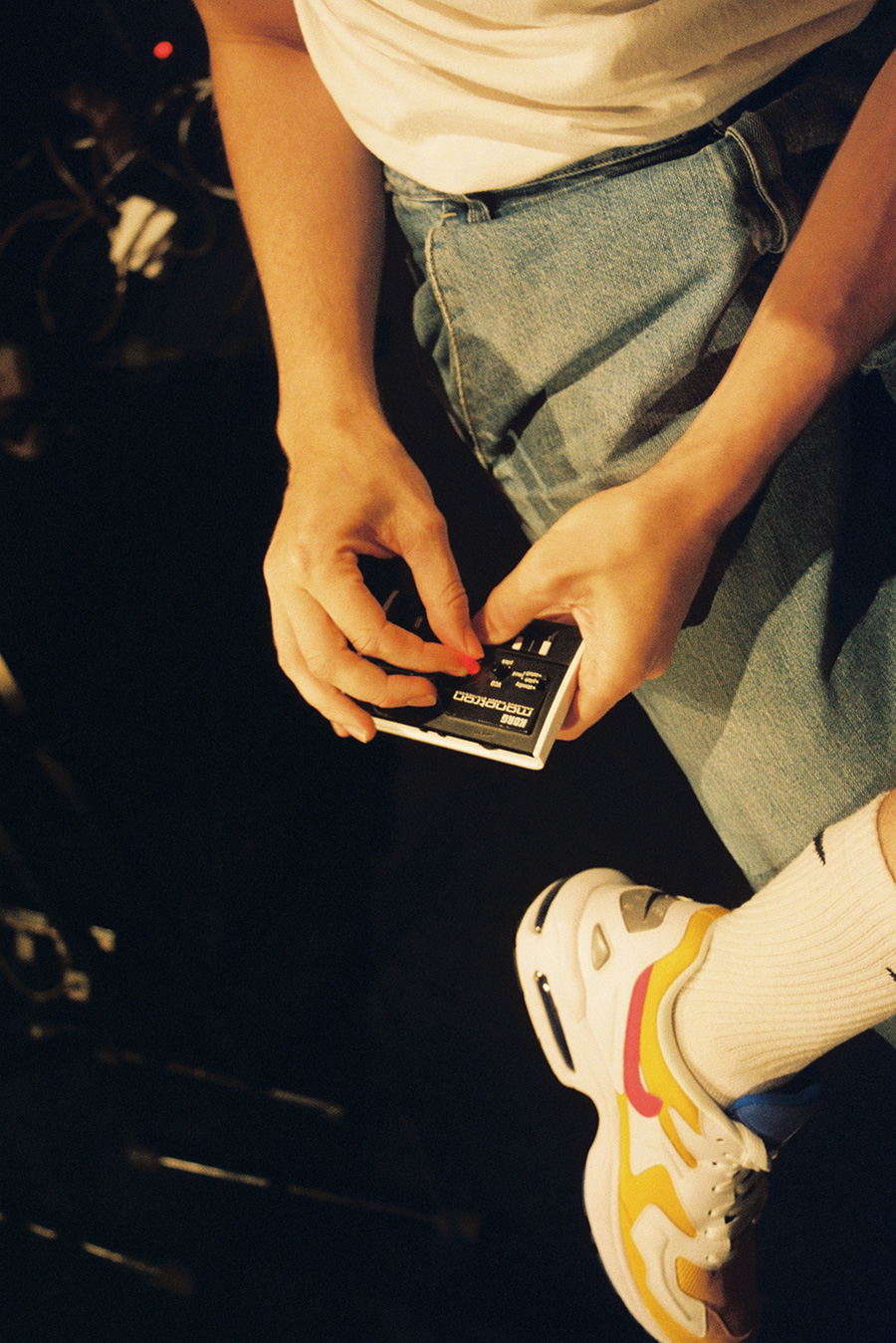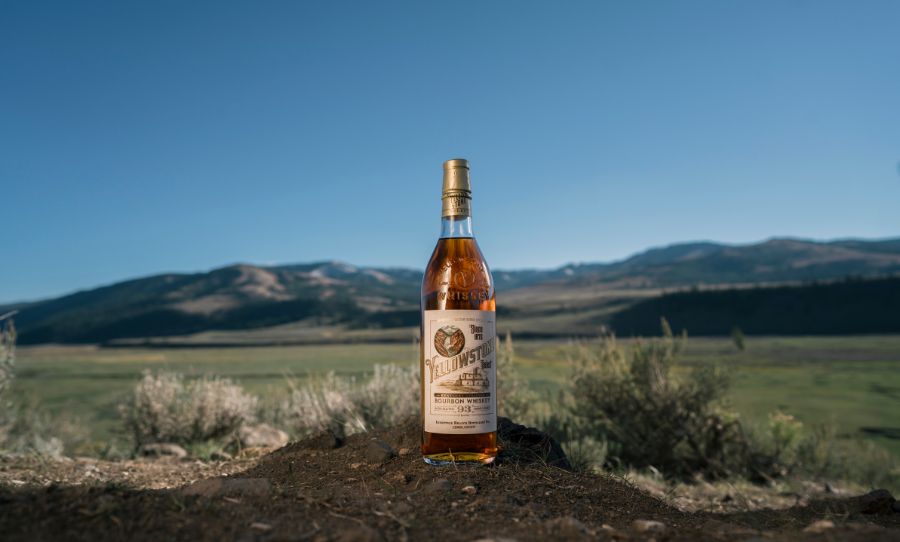We speak to Harvey Sutherland about the gear that’s vital to his sound, Korg fanboyism, and what it’s like to play live to Panorama Bar at 4am.
Harvey Sutherland, also known as Mike Katz, is one of Australia’s fiercest forces in funk. After carving a groove into the international 12″ circuit a few years back, Katz has consistently earned some of Australia and the world’s most coveted bookings; Dimensions Festival, Sugar Mountain, and tour spots with New Order, Hot Chip, and Khruangbin, to name but a few.
We recently spent some quality time in Mike’s Melbourne studio; a museum of analogue synths, rare drum machines, and enough organs to make the Vatican jealous. Here’s what we got up to.
This article appears in print in Happy Mag Issue 14. Order your copy here.

HAPPY: Let’s start somewhere nice and basic. Walk me through what you’re currently recording on?
MIKE: What I’m using currently? I run Ableton Live, like many people. It’s the thing I work quickest on – we do a lot of tracking in Logic and when I work with mix engineers I’ll use Pro Tools, because that’s just the done thing. But as far as getting ideas out and developing arrangements and, you know, trial and error sort of stuff, Ableton’s great and I work really quick on it.
HAPPY: And hardware-wise, I see a Juno-6, the Korg MS-20 Mini, what was the name of that monosynth?
MIKE: That’s a Vermona [Mono Lancet]. So that’s what I’m using at the moment, but I’ve also got the MIDI controller here running into the patch bay which can then play any of these hardware synths as well. You also have the occasional Korg M1 which gives everything a nice, ’90s flair.
HAPPY: How much do you jump around, because this room is just full of organs and… machines.
MIKE: I used to restrict myself, now I have this [studio] and it’s whatever I’m feeling in the moment. The Juno’s pretty commonly on stuff but I’m trying to be more broad with my synth palette. I try not to put Rhodes on anything anymore, I made that rule a little while ago. Like, ‘no more fucking Fender Rhodes.’ That I should probably sell as well. But I’ve replaced the Rhodes with that piano in the corner there, which is a really unique piece. It’s called a Helpinstill Roadmaster, it sounds great. Really clunky, really classic, Elton John-y. So that piano goes on a lot of stuff. I just like pieces which you don’t have to work too hard to get a nice sound out of them and that have a sound of their own.
HAPPY: Yeah, right.
MIKE: Like they’re not so common, there’s some character. There’s gotta be character. And you know, the Korg M1, it’s very common but it’s also how you treat it. So yeah, lots of bits.
“I try not to put Rhodes on anything anymore, I made that rule a little while ago. Like, ‘no more fucking Fender Rhodes.’”
HAPPY: Is there a place you always start?
MIKE: I’m usually starting at the piano, I’m literally just trying to write progressions and write a lot of ideas that feel good, and then everything else will come from that. But if I’m not there it’s in drum world and I’m building a loop, I’m sequencing a drum machine or playing stuff on top of it. I’ve been using Splice, actually, which is a really cool sample library, I signed up for that a few months ago and started finding little one-shot live drums, just building my kits up again. I got sick of using the same drum sounds, I’ve got a library I’ve been carrying around forever.
HAPPY: I was gonna ask that. How much real, recorded drums or drum machines make it to your recordings?
MIKE: I mean, this room is our live tracking room as well. For a lot of stuff, just stuff I’ll be making with the band. So it’s rhythm section, bass, drums, keys, percussion, and we’ll actually… I’ll have ideas, I’ll bring that to the band, and we’ll actually track all of that live in here and Phil – who I share the studio with – he’s our engineer for that stuff. So you know, there will be live sessions, which I’ll then take away and build arrangements out of. But then when I’m working in a solo capacity, it’s more starting from scratch.
HAPPY: In terms of what classically makes it on record, though, are you building things entirely in the box or do you usually end up live tracking? Or is it a mix?
MIKE: It’s a mix of stuff. I try not to be inhibited by a particular process or anything. I’ll definitely, you know, start something on the MPC and build a two-part idea and it’s a minute demo. I’ll send that to the band and go, ‘alright let’s just jam on this for 10 minutes and see what happens, enjoy it.’ That’s been how a lot of the stuff has evolved. They’ll just be seed ideas, then we get a rhythm bed, and then I’ll take that away again, and overdub, rearrange, and cut fills together. You end up with a very different track, often we’ll track something in the room and I’ll just get rid of the bass and write a whole new song to it.

HAPPY: So a lot of it that comes out of that live improvisation.
MIKE: I mean, that’s a real… things happen in that environment that would not happen otherwise, that’s why working with people is so great.
HAPPY: And you believe in following that instinct?
MIKE: Definitely. Not always, but yeah.
HAPPY: Just when it’s good?
MIKE: [Laughs] When it’s good. When, you know, when there’s a really great riff or something that comes out, I’m going to loop two bars of that and just build something completely new on it.
HAPPY: Now, you’ve had some of this gear for a while. Is there something in here that you think that you’ve gotten the most value out of?
MIKE: As far as sonic value? The MS-20 was pretty game changing, I think. Just in terms of a really broad palette of interesting and never-creatable-again sounds… the thing is a moving beast, you can never really get the preset back.
HAPPY: Has that ever meant a heartbreaking moment?
MIKE: [Grimace] It’s fine, I don’t hold on to that stuff. You know, really good tune exists in the moment. That’s it, hope you tracked it properly.
HAPPY: It’s off to tone heaven.
MIKE: But that thing, you could make a whole album out of that thing. I’m sure people have. Love the MS-20, I’ll always rep Korg.
“The MS-20 was pretty game changing, I think. Just in terms of a really broad palette of interesting and never-creatable-again sounds… the thing is a moving beast, you can never really get the preset back.”
HAPPY: So that’s a manufacturer that you really gel with?
MIKE: Yeah, actually I went to their showroom and their headquarters in Tokyo recently. They invited me to go and see all their new shit, and I met this guy Fumio Mieda, who was the chief engineer at Korg in the ’70s. He designed the MS-20 and the MiniKorg, which was the original Korg instrument. And he’s still there. He still works at the company. He’s like their quality control officer. They’re just, you know, they’re just amazing.
HAPPY: No, I think that too. A couple of those classic pieces are still really strong. But also I like… how much do you dip into the consumer, entry level stuff?
MIKE: Oh, all the Volca shit’s amazing.
HAPPY: To me that’s like really forward thinking, really groundbreaking. It’s keeping them relevant.
MIKE: I’ve got the Monotron, which was the first thing they did in that series. This was the first little analogue synth that they made, this was in 2009 or something and it’s just a noise-maker, really. But when they did this, I was like ‘holy shit, it’s an analogue synth in a tiny box.’ That’s an MS-20 filter.
[Mike attempts to get the Monotron working]
MIKE: When it works, it’s really fucking cool.
HAPPY: Does it have an out?
MIKE: It has an in! So you know, this was a $100 MS-20 filter. That was the first thing, and then there’s all of the reissues. Their development since then has been based on those same ideas; user friendly and accessible tools. Anyway, that’s enough Korg.

HAPPY: Moving onto some live stuff, then. Have ever played solo as Harvey Sutherland?
MIKE: That’s how I started. I did, and I still do… very rarely now, but when I started putting tunes out and getting booked. I still DJed but I wanted to do a live performance, that’s always been my thing. I come from band world, but even when I was doing a solo thing I wanted it to be a performance on a stage. So I was playing just with Ableton and the Juno and a controller, doing live improv over the drum loops and building tracks on the fly and throwing them out. That was my show, really, for the first couple of years, I did a lot of touring in Europe doing that and getting to play in clubs. Like I played Panorama Bar with just a Juno and a laptop at four in the morning, and it was sick! Really daunting, because it’s not like it was a big production or anything, it was just running into a DJ mixer. My whole whole thing about doing the live show is that I wanted it to sound as good, I want to be as big and as compelling as the DJ that’s playing after me. Because mastered records on a purpose built sound system sound amazing and a DI’d computer and a sound card doesn’t necessarily sound as banging, so it was finding a way to be able to deliver that show sonically, and making up for any lack in sonics by just being a really good performance. Having people kind of go, ‘what the fuck is going on?’ Just like shredding the filter through that sound system. Compensating I guess.
HAPPY: So the decision was to go bigger, or more dramatic.
MIKE: Just taking up more space, I think, on a stage. I did a festival in the UK as a solo act and it just didn’t hit the right way because when you get to a festival point, it’s like people stop seeing you, they stop engaging with what you’re doing. In a club environment people can see what you’re doing and it is more engaging. But when you get onto a stage, that stuff doesn’t matter as much. The band was the natural way to do that, rather than, like, glitter cannons and shit.
HAPPY: I mean, what would you add if you had the budget?
MIKE: Lighting. Really good timed lighting and visual. And that’s coming, that I’m working towards… never mind CO2 cannons and stuff, but good lighting that’s timed to the music is really, really fucking effective.
HAPPY: Difficult, though.
MIKE: Yeah and I have these conceptions of it running by MIDI, almost programming the light show to run alongside everything that’s coming out of it. Like every light has a component that’s connected, sonically.
HAPPY: I can’t imagine it happening any other way. All the really impressively synced live shows I’ve been too, it would have to have been just incredibly complex MIDI programming.
MIKE: I’m working on it.
“I did a festival in the UK as a solo act and it just didn’t hit the right way because when you get to a festival point, it’s like people stop seeing you, they stop engaging with what you’re doing.”
HAPPY: When you’re with the band, are there still any sequenced or automated elements to the live show?
MIKE: Yeah. It’s not it’s not strictly an untethered live thing, there’s still a click track that Graeme [Pogson] will play along to. There’s a few bits of backing track which are additional keyboard parts and stuff that I can’t do because I don’t have six hands. When we don’t have a percussionist live there’s a few claps and stuff, but I try to keep it as live as possible. Because it’s fun.
HAPPY: You can barely tell, honestly.
MIKE: Well it’s not a static backing track either. I’m using Ableton and I’m going through scenes as it comes.
HAPPY: Are you at a place where you can decide that on the fly?
MIKE: There’ll be set parts for each tune, but we can keep things going until we move on to the next section, or go back… it’s flexible. And that’s awesome.
HAPPY: You also DJ, did you start DJing on vinyl or CDJs?
MIKE: I mean, I’ve been DJing and putting mixes together since I was 13 or something. I think I was using software, like some really primitive…
HAPPY: Like Traktor?
MIKE: It was pre-Tracktor, it was for radio stations that wanted seamless music. But it was a two turntable style thing that you could just use to mix mp3s. I actually learnt to beat match on that because you would be able to push and pull the the pitch, and ride the pitch.
HAPPY: With the keyboard, right?
MIKE: Yeah! Like F11 and F12. This was my beginning of learning how to beat match.Then when I started doing club stuff I learnt to CDJ on the job and then started bringing records into it. But all the principles remain the same, like I ride the pitch. I actually try not to touch anything on the platter, I’m strictly a pitch riding kind of guy. I don’t know whether that’s so common, but that’s always been how I’ve done it.
HAPPY: You’ve just unlocked a crazy memory of mine where I had like a mate in the back of the car, DJing with a laptop and an AUX to the front of the car. It was a long drive, and it was a total mess.
MIKE: But it was accessible! It was a demo program, it was like, ‘this is how I’m gonna learn how to do this.’

HAPPY: True. As accessible as DJing is now, if you actually want to get into it there’s a couple of big purchases that you have to make.
MIKE: I don’t know many people that have Nexus 2 CDJS, but I would love to have those at home just to actually learn how to use them inside and out. You know most people just learn them on the job and every set they might figure out what one button does, but I still don’t know how to fucking use it.
HAPPY: Man, I only recently learnt about RekordBox.
MIKE: That was more recent… I always said ‘I don’t need that.’ But it’s life-changing.
HAPPY: If not CDJs, do you have turntables and a mixer at home?
MIKE: I haven’t got a setup at home, but yeah, I’ve got a couple [Technics SL-1200s] and a mixer should I feel the urge to throw down. But I don’t think my girlfriend would be very happy about that.
HAPPY: What’s your record collection like?
MIKE: Uh… it’s still significant. I’m getting rid of stuff.
HAPPY: I saw you occasionally do a market stall?
MIKE: I did! I did a market store and I had a really good time. I’m trying to scale down. I’ve ripped a lot of stuff and I was going through the other day thinking, ‘I don’t need to hold on to these 12-inches,’ you know? There’s some records that are really important, but you should rotate.
HAPPY: Do you do much sampling?
MIKE: Not really. I had a brief moment with that. But that’s a skill in itself, and it’s not really a skill I think I have – finding and sort of chopping good samples. I’d rather just try and make a weird sound.
This article appears in print in Happy Mag Issue 14. Order your copy here.



